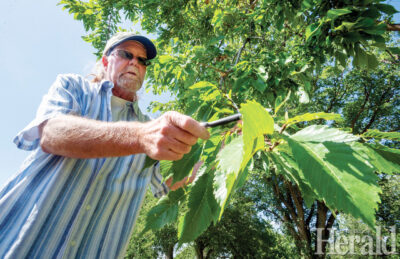Vigilance urged to prevent Dutch Elm Disease in city
By Al Beeber - Lethbridge Herald on April 8, 2023.
 Herald file photo
City urban forestry technician Lindsay Bell points out some of the features of an elm tree in a northside greenspace in 2020 after two trees that summer were discovered to be infected with Dutch Elm Disease.
Herald file photo
City urban forestry technician Lindsay Bell points out some of the features of an elm tree in a northside greenspace in 2020 after two trees that summer were discovered to be infected with Dutch Elm Disease.LETHBRIDGE HERALDabeeber@lethbridgeherald.com
Just say no to bugs! The ones responsible for Dutch Elm Disease, that is.
Three years after the second confirmed case of the disease in Alberta was found in Lethbridge, the threat of devastation remains strong.
The disease is caused by a fungus that clogs the water conducting system of elm trees, resulting in their deaths. It’s spread from tree to tree by three species of beetles.
The beetles, according to the Alberta government, are attracted to trees which are weak and dying, those trees serving as breeding sites for the insects. When the beetles have pupated and become adults, they fly to healthy elm trees to feed, transporting the fungus in the process on their bodies.
Alberta has the largest DED-free stand of trees of American elm in the world, according to the province and with no replacements for elm shade trees on such a massive scale, introduction of the disease could cause huge losses.
Lindsay Bell, an urban forestry technician with the City of Lethbridge, said Sunday during the Environment Lethbridge Seedy Sunday event, people need to be vigilant when transporting firewood to ensure the disease doesn’t appear in Lethbridge again.
“If you’re taking a piece of firewood and bringing it into Lethbridge from somewhere, you could bring in all these beetles,” said Bell, pointing to a display of tiny beetles on a table.
“That’s why we tell people ‘don’t move firewood’ because we’re this little forested island here in Lethbridge and the potential for bringing pests in . . . moving firewood around of any species could potentially bring invasive insects into our area.
“And that’s how we figured Dutch Elm Disease showed up when we had it in 2020. There’s a lot of Dutch Elm Disease in Saskatchewan right now and what’s happening is a lot of these corporate farms are buying up land and bulldozing all the shelter belts and everything. So there’s a lot of wood there infested with beetles, and of course we had COVID and everybody is sitting at home and decided ‘let’s go camping.’ So as we work with the Society to Prevent Dutch Elm Disease, we’re really watching those corridors coming from Saskatchewan into Alberta because that’s where people are travelling and could potentially be moving firewood and introducing Dutch Elm Disease into Alberta,” said Bell.
“So that’s our big push. Be careful. When you’re travelling around, don’t travel with firewood.”
The technician said another beetle, called Emerald Ash Borer, arrived in North America in 2003 and is spreading. The beetle has just been discovered in Winnipeg – the only place in the Canadian Prairies known to have it.
“We’re really worried about that because basically half our urban forest is ash and elm trees. That’s our prominent species,” Bell said.
Because of concerns about infestations he said it’s important to diversify the urban forest by planting more oak, maple and linden trees.
“We want that diversity in our urban forest,” Bell added, to help act as a buffer.
Nothing can be done to combat DED, he said.
“There is a fungicide but it doesn’t work very well so pretty much if you find a tree with Dutch Elm Disease, cut it down and get it out of there before you end up having more trees getting Dutch Elm Disease,” Bell said.
City crews go out all summer and watch for symptoms which include leaves on branches suddenly wilting, drooping or curling, as well as leaves turning yellow then brown and shrivelling while staying on tees.
Symptoms are also visible under the bark of trees. Healthy elm wood is cream-coloured but diseased trees will have dark brown or red streaks visible.
Trees that are infected later in the summer will have leaves that droop, turn yellow and prematurely drop, says the province.
“Late season infections are easily confused with normal seasonal changes in leaf colour,” says an information page on the Alberta government website.
Bell said the fungus clogs the vascular system of a tree, causing it to wilt and branches die because moisture can’t get up into the canopy of a tree.
City crews inspect all the elm trees here twice a year, Bell said.
“If we see something strange, we’ll sample it and send it to the provincial plant health lab and they’ll determine if it’s Dutch Elm Disease,” said Bell, adding three vascular wilt diseases exist and they can’t be differentiated without lab samples being taken.
Lethbridge’s case of DED was only the second ever in Alberta, the other being in 1999 in Wainwright.
“Everybody’s pretty vigilant,” Bell added.
Canadian Border Services Agency staff at crossings ask visitors from the U.S. if they’re bringing firewood into Canada and bins are set up to collect it, he said.
Follow @albeebHerald on Twitter
29-28


